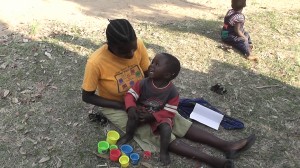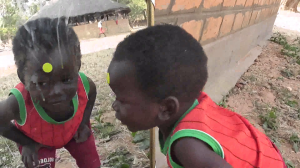The broad aim of this line of research is to explore the social construction of self. One way to achieve this is to explore cross-cultural differences in the early development of self-awareness.
In some countries early caregiver-infant interactions are characterized by high levels of proximal physical contact, whereas in others, distal contact strategies (high levels of speech and mutual eye gaze) are most commonly used. Culturally distinct experiences such as these may scaffold collectivistic (interdependent) versus individualistic (independent) concepts of self.
In support of this claim, we find that the quality of early caregiver-infant interaction can be used to predict infants’ pass rates on self-recognition tasks. Specifically, infants exposed to an individualistic parenting style have the advantage in a task requiring recognition of the self as a distinct individual (the mirror mark test of self-recognition), whereas infants exposed to a collectivist parenting style have the advantage in a task requiring recognition of the self as an interdependent object in the environment (the body-as-obstacle task).
Remarkably, this is among the first data to empirically substantiate the idea that social factors play a role in the early construction of self (see: Ross, J., Yilmaz, M., Dale, R., Cassidy, R., Yildirim, I. & Zeedyk, M.S. (2016). Cultural differences in self-recognition: The early development of autonomous and related selves? Developmental Science.doi: 10.1111/desc.12387).
The antecedents of self-awareness are an open question. For a long time, the development of self-recognition was considered a fixed cognitive development, perhaps deriving from the domain general development of secondary representation. However, there is growing evidence to suggest that self-other differentiation is impacted by, and impacts, social development. Arguably, we may need to define and measure self-awareness more broadly than mirror self-recognition if we are to elucidate the antecedents (and social consequences) of self.
Cross-sectional research employing the mirror mark test of self-recognition has dominated research focused on the development of self-reflection in children. However, the mirror mark test may fail to capture the complexity of self as a social object, and the developmental antecedents and consequences of self-reflection remain largely uncharted.
Mini me PhD graduate Dr Yaro Goncharova has confirmed that Stipek’s (1990) self-concept questionnaire offers reliable multidimensional measurement of the development of self-awareness, encompassing self-recognition, self-evaluation, emotional responses to wrongdoing and autonomy. Interestingly, Yaro finds that this parent report scale has the same developmental correlates of mirror self-recognition. Yaro’s cross-sectional research found that self-reflection as captured by the self-concept questionnaire could be predicted by concurrent developments in imitation, pretend play and prosociality.
Offering a snapshot of development over 3 months for 74 children aged between 14 and 36 months, Yaro also found that increases in self-reflection captured by the multidimensional self-concept questionnaire were longitudinally related to developments in pretend play, prosocial behaviour, imitation and declarative pointing. However, although baseline self-reflection was statistically predictive of children’s prosocial behaviour at follow-up (confirming a link between he self and ‘moral’ behaviour), no strong developmental predictor of self-reflection emerged. See Who am I? A longitudinal investigation of the multidimensional self. More longitudinal research, moving beyond or supplementing mirror self-recognition, is needed to identify the cognitive and social precursors of self-reflection!



